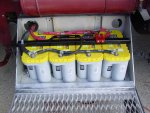Yeah, and I just sent a 40yo wet-cell off to the recyclers, one winter in the CO Rockies was all it had left! Newer chemistries, done right, make that the rule instead of the exception. In a creek, your chassis becomes "earth grounded" but once you're back on land, it's back to "floating ground." A plastic tub of water sitting on a wood deck, would be a better destructive-battery-test rig than an earth-grounded bathtub, come to think of it. Wouldn't want to start gassing off hydrogen inside the house, now, would we?

I was considering a positive-ground solar system on the GMC, but decided against it for not being "failsafe" i.e. if anything goes wrong, the chassis would be "hot" with enough current to knock out any grizzly bear touches it, although the occupants would be safely isolated by the rubber tires. This sort of arrangement isn't without its uses, but it's more EM-50 UAV than civvy motorhome. But, "positive ground" is a misnomer on a floating-ground vehicle, the more-precise term is "reverse polarity."
The GMC has the added virtue of being a rolling Faraday Cage (many vehicles are, to one extent or another, but there's a reason that one trailer in several old X-Files episodes is an Airstream). Yeah, I'd love to avoid all the microprocessors in that Quattro inverter/charger, let alone the software that needs a PC to run, but I'll make an exception to my general rule, for the GMC and the FLU battery boxes... All external power connections will pass through isolation transformers, even if they aren't called that. In the event of a large solar flare or nearby lightning strike, I ought to be safe from Electro Magnetic Pulse (EMP) damage inside a hollow, ribbed-cage aluminum tube with some fine aluminum mesh embedded in the insulation we'll be spray-foaming in there. As long as I'm "floating ground" and not stuck in a creek or something, at the time.
The FLUs aren't much susceptible to EMP, unless you install batteries with integrated circuits on board. In which case, line the battery box with some Al or copper mesh, heck even galvanized-steel chicken wire will do, for making the box a more effective Faraday Cage. I'm more worried about lightning than solar flares, either way I'd hate to see my infrastructure investment get zorched, so I'll be doing a little work to the battery boxes on my FLUs to prep them for the LFP batteries. Note that my SEE parked outside is earth grounded atm, because I'm using the bucket as a parking brake, so the chassis is directly connected to wet earth despite the rubber tires.
Positive-grounding a solar PV array ensures that all accumulated charge drains to the batteries. Otherwise, once the light level drops, those ions radiate back into the atmosphere as heat. It takes time for this to occur, so the more sophisticated systems are capable of temporarily reversing polarity when these conditions occur, as it takes 1/10th the time to drain that charge to the battery bank, as it did for that charge to build up. Or you can just go reverse-polarity solar full-time, with the caveat that any short-circuit makes the chassis "hot" to anyone outside the floating-ground RV. Otherwise, all the lights, fans and such running DC can just be hooked up "backwards" no problem, but any step-down converters to 12V need to be the isolating type to deal with the polarity inversion. Higher-end inverters don't care about DC polarity, and are inherently "isolation transformers" to AC power, in such a setup.
It's a routine 20 below out, right now, I had to set my faucets to dripping to keep the pipes from freezing up. I just got back inside from lugging in firewood, and plugging in the block heater on the Dodge. What's left of the pickup-truck batteries I put in the SEE, won't start it tomorrow (not that I was planning to, lots of snow flurries not amounting to anything, here) until it warms up in the afternoon, it woulda needed a jump-start until late this afternoon as it never got above 10*F. Cold-starting the SEE without pre-heat made quick work out of a pair of batteries I bought 3 1/2 years ago, whole lotta deep cycling since I rotated 'em into the dead dually then the SEE, they're about done. They're Interstates so I'll just swap 'em out on warranty, and put batteries back in the dead Dodge so I can tow-strap it down the road with working brake lights, and start the 12V (as in Valve) crate motor I'll be putting in it at some point.
Temporary battery swap amounted to 10 weeks, unless it warms up again in which case they'd prolly start the SEE just fine until next winter, but yeah I abused those Interstates the past few months, so no surprise they're off to an early grave. I'll also be insulating the FLU battery boxes, for the sake of those integrated heaters in the new batteries. I went three weeks in February on the propane furnace, as it was too warm to light the woodstove, now I'm just shoveling the logs in it again!





